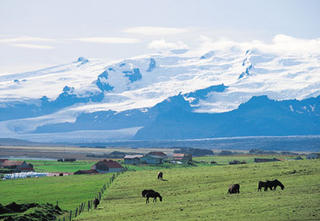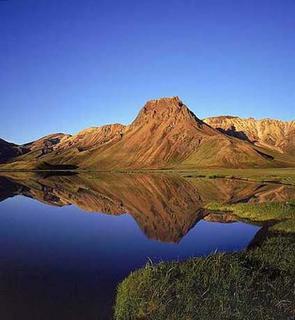


Iceland - When economics meets environment
Karahnjukar Hydro Electric Project
In Iceland it is easy to be environmentally correct. The country has a small population, large tracts of uninhabited land, almost no polluting industry, and the ability to live off geothermal and hydroelectric power without using fossil fuels except for automobiles. The lack of natural resources also means that there is very little to export except for products that come out of the ample surrounding ocean. You cant export hydro-electricity if you are an island nation. The next best option is to bring in industries that are thirsty for electricity. That has set economics and environmental issues on a collision course like everywhere else in the world. The Karanjukkar hydroelectric project is building a dam across two glacial rivers Jokulsao a Dal and Jukulsa i Fljotsdal flooding a remote part of the already remote Eastern Highlands. The power from the project will be used exclusively by the American aluminum company Alcoa in nearby Reydarfjordur creating jobs in an economically deprived area dependent mostly on fishing. The week before I got there angry environmentalists had camped out near the site and chained themselves to the construction equipment to protest the dam.
I cannot comment on the issues as I had not researched them. But to my untrained eye it looked like in the barren, desolate, cold, windswept, mountain side and valley that was being flooded there was really no life to protect – no trees, no animals, no plants, not even grass, or birds. The nearby town of Reydarfjordur, population 650, could do well with the 1000 new jobs expected to be created.
The dam is being constructed by the Italian company Impreglio and we are guests of some engineers working on the project. It is the fourth largest, earth fill dam in the world, possibly at the highest elevation, and definitely the one closest to the north pole. Nothing screams globalization like what I see here. The project site is one of the most remote, desolate, barren, and inhospitable work locations I have been to. All of a sudden it has created a new reverence inside of me every time I flick a light switch because I realize that someone gave a big chunk of their working life, living on a harsh project site to pipe electricity into my house. Toiling away on the project site are professionals from 43 countries. In the club house and dining halls I hear Icelandic, English, Italian, Chinese, Portuguese, Hindi, Urdu, Russian, Spanish, Arabic, French, Nepali, Malayalam. To my delight there is even a Malayalam speaking procurement specialist called Babu from the Indian town of Trissur where my parents live. We unleash verbal volleys in the machine gun style rapid fire exchange of our mother tongue. “Babu, ivade vannu yetra kallum aayi?”
During a visit to the restricted construction site I stand in awe outside the cavernous water intake tunnel. The tunnel will be submerged below the waters and carry massive quantities of water down a 500 foot drop to the bottom of the mountain that will power the giant turbines. Emerging out of the tunnel driving various kinds of earth moving equipment in an ant like fashion are workers of various nationalities, a lot of them Chinese. I am told that there are over 300 Chinese working on this project. Given the number of hydro-electric projects in China it is one of the best sources of skilled workers experienced in operating complex dam construction equipment such as tunnel boring machines. The Chinese ambassador to the region is visiting the project site to acknowledge their contribution and the Chinese flag is flying on the flag mast outside the dining hall. I had always imagined the Chinese economic power to mean simple things like the toys in Toy’R Us to be manufactured in Guangdong or the washing machines in Circuit City to come from Shenzhen. In more complex examples it meant to me that US Government bonds are being increasingly held by Chinese investors and that the Baltic Shipping Index is at an all time high because the Chinese are buying up all available shipping capacity. But this is stretching the limits of my imagination. Globalization is at work in remote eastern Iceland highlands unseen by the editors of The Economist and the Wall Street Journal. Chinese labor working for an Italian company is generating Icelandic electricity to fuel an American aluminum plant to boost the Icelandic economy. This would make the editor of Mother Jones spill his coffee in outrage.
To beat the loneliness and monotony of the project site the project team has found interesting deviations. The Indians, Pakistanis, and the Nepalese have a cricket club and I am invited to join a game. It is a surreal sight to be playing cricket at 10PM at night under the artic sun, in the shadow of a glacier, in cold windswept conditions, close to the artic circle. The founders of the game had intended the game to be played during the English summer wearing white flannels on a grassy field with a break for tea. Later they exported the game to their warm tropical colonies. But Wisden would never have thought that the sounds of “Howzaat” would be heard near the north pole.
Late at night, after a post-game chat session with some of the cricket players, I am trying to find my way to the guest rooms reserved for us in one of the living quarters, I stumble across a raging party. The gym where I had exercised earlier is now the scene of strobe lights and dance music. The people working on the project are kicking up a fuss on the dance floor. Two young men, who look to me of Latin American extraction and in their twenties stop to chat with me. They tell me that the party is hopping but there are not enough girls to dance with. Apparently, they had invited the “Sodexho girls” – the Icelandic girls who work for the catering and cleaning services contractor Sodexho on the project site. But most of them did not show up. I reassure them that some problems are universal. Their friends attending parties at the Copacabana in New York city or the Velvet Lounge in San Francisco would be bemoaning similar gender ratios at their parties. I encourage them to get back on the dance floor and work their salsa, mergengue magic.
(photo credit: Iceland Tourist Board, Linknot.com)



